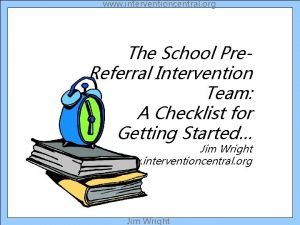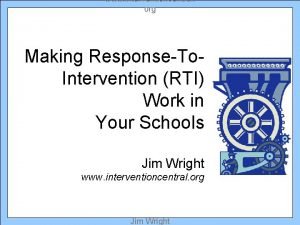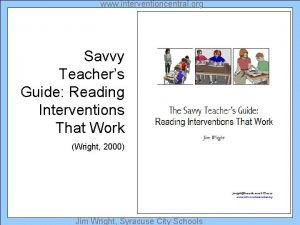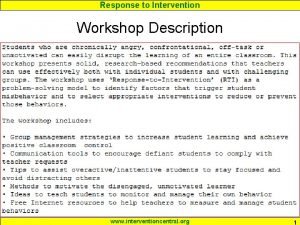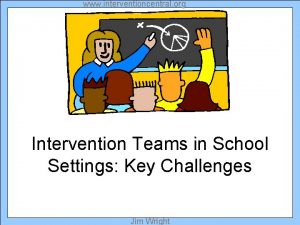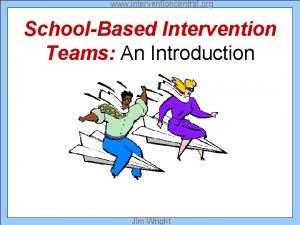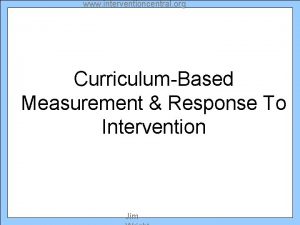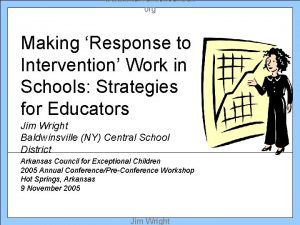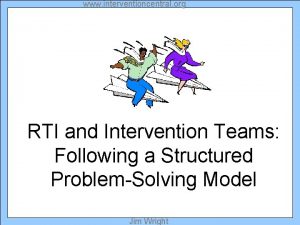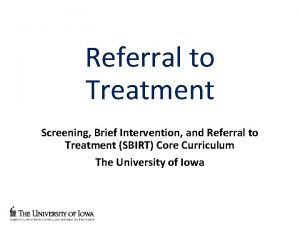www interventioncentral org The School Pre Referral Intervention











- Slides: 11

www. interventioncentral. org The School Pre. Referral Intervention Team: A Checklist for Getting Started… Jim Wright www. interventioncentral. org Jim Wright

www. interventioncentral. org New Teacher Support Teams: Stages of Adoption 1. Finding a Good Fit. Team structured problem-solving process seems artificial. Members can experience some anxiety, frustration: ‘Why can’t we just have a natural conversation with the referring teacher? ’ 2. Hitting Its Stride. Team starts to internalize the problem-solving model and find it more ‘natural’. Members begin to automatically use the model to frame any teacher concern. (Example: ‘So what do you think is the function, or ‘driver’, for this student’s calling out in class? ’) Jim Wright

www. interventioncentral. org Teacher Support Teams: Stages of Adoption (Cont. ) 4. Building Capacity. Team finds that it receives many referrals for same problem (e. g. , poor reading skills, lack of work completion). Decides to increase its capacity to handle these common referrals (e. g. , setting up a peer tutoring program, building an intervention bank, offering mini-clinics to teachers in effective intervention techniques, etc. ) 5. Planning for the Long-Term. The team recruits new members to join as current members rotate off. Staff understanding and use of problem-solving model becomes part Jim Wright

www. interventioncentral. org SBIT Consultative Process Step 1: Assess Teacher Concerns Step 2: Inventory Student Strengths and Talents Step 3: Select Target Teacher Concerns Step 4: Set Goals Step 5: Design an Intervention Plan Step 6: Plan How to Share Information with the Student’s Parent(s) Step 7: Review the Intervention and Monitoring Plans Jim Wright

www. interventioncentral. org What should not be changed in the SBIT model? • The school strives to have diverse representation on the team, including teachers • Referring teachers are treated by the team as valued colleagues, with courtesy and respect • The team follows the general 7 -step problemsolving model • All team members share the rotating roles (facilitator, recorder, time-keeper, case liaison) • The team uses ‘research-based’ interventions • The team measures student progress to determine whether interventions are effective Jim Wright

www. interventioncentral. org What can be changed in the SBIT model? • Forms can be changed (e. g. , different terms, simplified layout, etc. ) to meet school’s needs • Meeting time can be shortened or lengthened • Meetings can be held more or less frequently • Team can decide to target specific building populations (e. g. , grades 1 -3; special education students; all initial student referrals, etc. ) Jim Wright

www. interventioncentral. org Jim Wright

www. interventioncentral. org Intervention Team: Next Steps… Step 1: Establish a clear team process and meeting procedures, to include: • selecting a regular meeting time that is most convenient for team members and referring teachers. • finding a suitable meeting place. • establishing a system for responding promptly to teacher referrals. • working out procedures for communicating efficiently among all team members. Jim Wright

www. interventioncentral. org Intervention Team: Next Steps… Step 2: Publicize your team and its services to your faculty, other staff, and parents by: • scheduling time at a faculty meeting to present a team overview. • presenting brief ‘updates’ about your intervention team at faculty meetings throughout the school year. • writing up a short team description and placing it in all teacher mailboxes. • presenting a workshop on the intervention team to your PTO. • offering occasional professional-development Jim Wright

www. interventioncentral. org Intervention Team: Next Steps… Step 3: Create an inventory of resources in your building that your team can use by: • making a list of locations around the school that can be used as space for interventions. • writing down names of staff volunteers willing to help with implementing and/or monitoring interventions. • creating a directory of staff willing to serve on your intervention team whose training or professional experience gives them expertise in key intervention topics (e. g. , reading instruction, behavior management). Jim Wrightmaterials, rewards, • identifying instructional

www. interventioncentral. org Intervention Team: Next Steps… Step 4: Try out the team roles, meeting procedures using referrals from team members before taking referrals from the entire school. Follow all meeting steps: • The referring team member completes a written referral. • A case liaison is assigned to collect classroom information, academic and behavioralbaseline data. • An initial meeting is scheduled for at least 90 minutes. Jim Wright
 Interventioncentral.org
Interventioncentral.org Interventioncentral.org
Interventioncentral.org Interventioncentral.org reading
Interventioncentral.org reading Interventioncentral.org
Interventioncentral.org Www.interventioncentral.org
Www.interventioncentral.org School health additional referral program
School health additional referral program Askov dental health education
Askov dental health education Whats a referral in school
Whats a referral in school Znacznik pre /pre jest stosowany w celu wyświetlenia
Znacznik pre /pre jest stosowany w celu wyświetlenia School crisis prevention and intervention
School crisis prevention and intervention Hình ảnh bộ gõ cơ thể búng tay
Hình ảnh bộ gõ cơ thể búng tay
